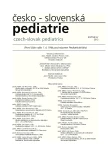Does the postnatal detection of renal pelvis dilation a higher risk of urinary tract infection?
Authors:
H. Flögelová 1; O. Šmakal 2; J. Hálek 3; K. Michálková 4; V. Švecová 4; J. Zapletalová 5
Authors‘ workplace:
Dětská klinika FN a LF UP, Olomouc
přednosta prof. MUDr. V. Mihál, CSc.
1; Urologická klinika FN a LF UP, Olomouc
přednosta doc. MUDr. V. Študent, Ph. D.
2; Novorozenecké oddělení FN, Olomouc
primář MUDr. L. Kantor, Ph. D.
3; Radiologická klinika FN, Olomouc
přednosta prof. MUDr. M. Heřman, Ph. D.
4; Ústav lékařské biofyziky Univerzity Palackého, Olomouc
přednostka prof. RNDr. H. Kolářová, CSc.
5
Published in:
Čes-slov Pediat 2012; 67 (4): 223-228.
Category:
Original Papers
Overview
Objective:
The authors investigated, whether children with renal pelvis dilation observed during a screening postnatal ultrasound examination represent a higher risk of febrile infection of urinary tract in the first two years of life as compared to children with a normal ultrasound finding.
Methods:
In the period of 2005 to 2008, ultrasound examination of the kidneys was performed prospectively in 6,088 in complete population of healthy newborns at the Faculty Hospital in Olomouc. All children with renal pelvis dilation higher than 5 mm measured in anterior-posterior intrarenal projection (APIR) were further investigated. These 236 children were divided into 4 groups according to renal pelvis dilation size (5–7 mm, 7–10 mm, 10–15 mm, ≥15 mm). The occurrence of febrile infection of urinary tract, obstructive uropathy and vesicoureteral reflux were investigated. In all remaining children of the basic cohort (5,852 children with normal ultrasound examination) we followed, whether they were hospitalized or treated in outpatient departments in the first two years of life for febrile infection of urinary tract. The statistical examination used chi-square test, Fisher exact test and the relative risk test.
Results:
The febrile infection of urinary tract in children with normal ultrasound of the kidneys occurred in 1.2%. In children with postnatal renal pelvis dilation of 5 mm or more the occurrence was 6.8% which proved to be significantly higher (p<0.0001). In the individual groups classified according to renal pelvis dilation the febrile infection of urinary tract was 6.2% in APIR 5–7 mm (p=0.0005), in 5.7% in APIR of 7–10 mm (p=0.044), in 13.3% in APIR 10–15 mm (p=0.056, non-significant) and in 20% in APIR 15 mm and more (p=0.237, non-significant difference).
The relative risk of occurrence of the febrile infection of urinary tract above 5 mm vs. below 5 mm, the relative ratio was 5.67 (95% CI 3.20–9.80).
Conclusion:
In our cohort the children with the postnatal detection of renal pelvis dilation there was a significantly higher risk of febrile infection of urinary tract in the first two years of life as compared to children with a normal ultrasound finding in the kidneys.
Key words:
renal pelvis dilation, infection of urinary tract, postnatal ultrasound screening
Sources
1. Miklovicova D, Cervenova O, Cernianska A, et al. Long-term follow-up of renal function in patients after surgery for obstructive uropathy. Pediatr Neprol 2008; 23: 937–945.
2. Lee RS, Cendron M, Kinnamon DD, et al. Antenatal hydronephrosis as a predictor of postnatal outcome: a meta-analysis. Pediatrics 2006; 118: 586–593.
3. Roth CC, Hubanks JM, Brigit BC, et al. Occurence of urinary tract infection in children with significant upper urinary tract obstruction. Urology 2009; 73: 74–78.
4. Anderson NG, Fischer J, Leighton D, et al. Management in children of mild postnatal renal dilatation but without vesicoureteral reflux. Pediatr Nephrol 2010; 25: 477–483.
5. Katzir Z, Witzling M, Nikolov G, et al. Neonates with extra-renal pelvis: the first 2 years. Pediatr Nephrol 2005; 20: 763–767.
6. Coelho GM, Bouzada MCF, Lemos GS, et al. Risk factors for urinary tract infection in children with prenatal renal pelvic dilatation. J Urol 2008; 179: 284–289.
7. Mami C, Paolata A, Palmara A, et al. Outcome and management of isolated moderate renal pelvis dilatation detected at postnatal screening. Pediatr Nephrol 2009; 24: 2005–2008.
8. Mami C, Palmara A, Paolata A, et al. Outcome and management of isolated severe renal pelvis dilatation detected at postnatal screening. Pediatr Nephrol 2010; 25: 2093–2097.
9. Marild S, Jodal U. Incidence rate of first-time symptomatic urinary tract infection in children under 6 years of age. Acta Pediatr 1998; 87: 549–552.
10. Shortliffe LM, McCue JD. Urinary tract infection at the age extremes: pediatrics and geriatrics. Am J Med 2002; 113 (Suppl 1A): 55S–66S.
11. Hálek J, Flögelová H, Michálková K, Šmakal O, et al. Diagnostic accuracy of postnatal ultrasound screening for urinary tract abnormalities. Pediatr Nephrol 2010; 25 (2): 281–287.
12. Coulthard MG. Vesicoureteric reflux is not a benign condition. Pediatr Neprol 2009; 24: 227–232.
13. Penido Silva JM, Bouzada MC, Vergara RM, et al. Clinical course of prenatally detected primary vesicoureteral reflex. Pediatr Nephrol 2006; 21: 86–91.
14. AAP: Urinary tract infection: clinical practice guideline for the diagnosis and management of the initial UTI on febrile infants and children 2 to 24 months. Pediatrics 2011; 128 (3): 595–610.
Labels
Neonatology Paediatrics General practitioner for children and adolescentsArticle was published in
Czech-Slovak Pediatrics

2012 Issue 4
- What Effect Can Be Expected from Limosilactobacillus reuteri in Mucositis and Peri-Implantitis?
- The Importance of Limosilactobacillus reuteri in Administration to Diabetics with Gingivitis
Most read in this issue
- Does the postnatal detection of renal pelvis dilation a higher risk of urinary tract infection?
- Total anomalous pulmonary venous return – uncommon cause of failure to thrive in infant
- GM1 gangliosidosis associated with multiple mongolian spots
- Application of ultrasonography in the diagnostics of pyelonephritis
